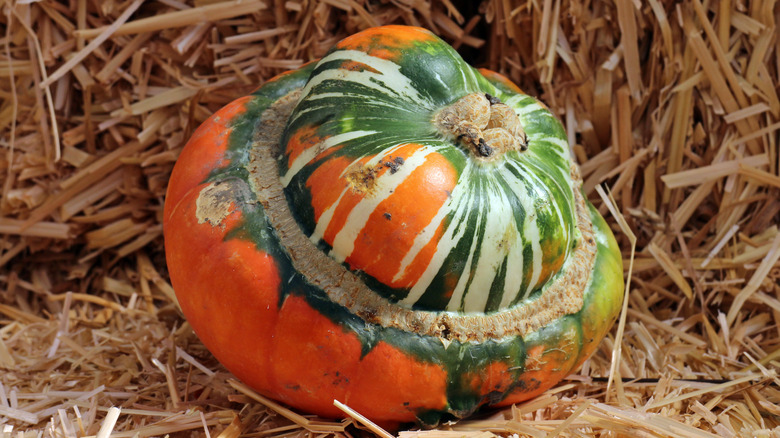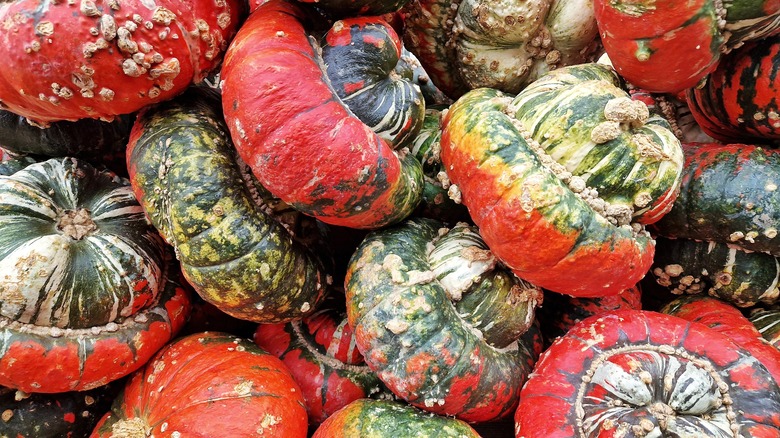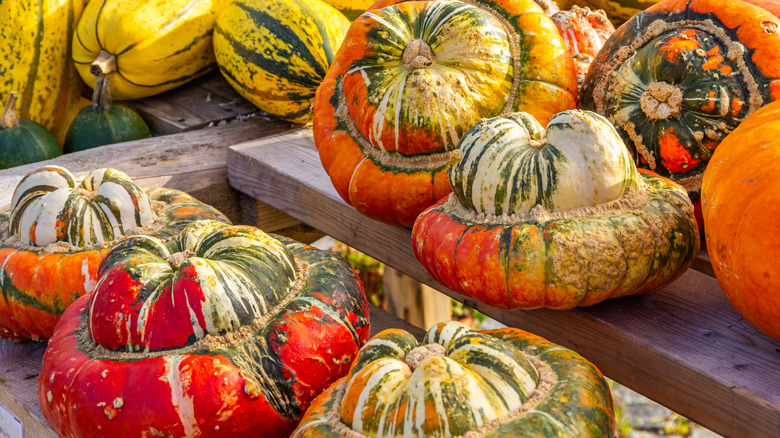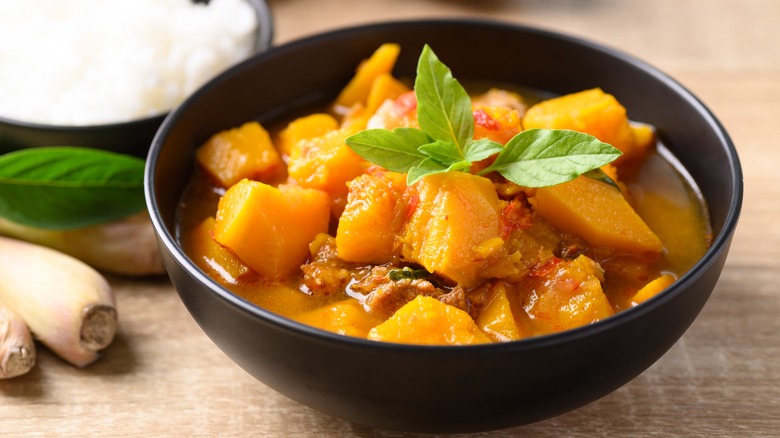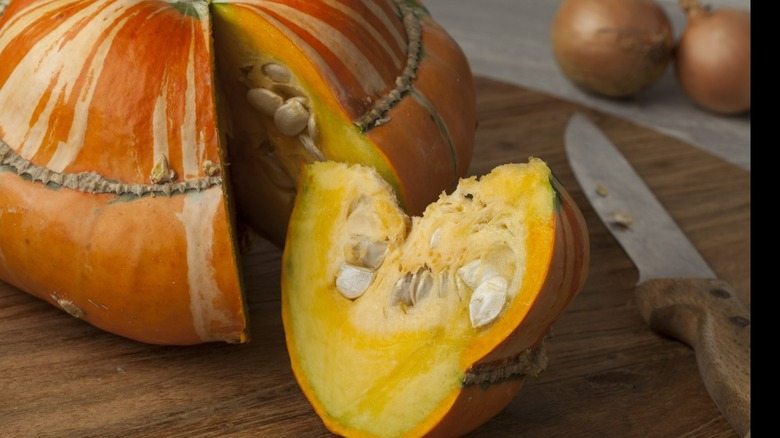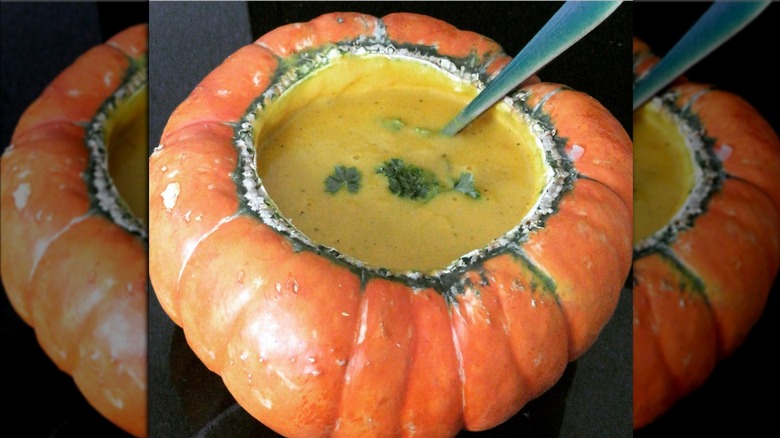Turban Squash Is The Underrated Veg You Should Be Cooking Up This Fall
You know those ornamental squash and pumpkins you see in fall cornucopia displays? One that you may be surprised to learn is edible is the turban squash, shown above. Named for its turban-like shape consisting of a mushroom cap-shaped brim at the stem end, and a bulbous protrusion at the blossom end, the turban squash often grows to be over a foot in diameter and can weigh in the vicinity of five pounds, according to Specialty Produce.
It's a member of the Curcurbitaceae family, which Genetic Engineering of Horticultural Crops (via ScienceDirect) informs us includes not only pumpkins but cucumbers and melons. Of course, the classification of turban squash (Cucurbita maxima) is just a science-y way of referring to "winter squash," according to North Carolina State University Extension. And that, right there, might be the key to understanding what the vastly underrated and highly underutilized turban squash is, how it's used, and how best to go about using it in your own kitchen.
What is turban squash?
Turban squash varieties include the American turban, Mexican hat, and Turk's turban, per Specialty Produce, but all share the turban shape, brilliant coloring (including red, orange, yellow, green, and white), and stripey markings. They also all share a dense and starchy flesh that's mild, sweet, and slightly nutty in flavor, like many other winter squashes, including butternut and acorn. In addition, all are considered "heirlooms," which Burpee explains means that they've been naturally pollinated over a period of at least 50 years. Of course, turban squash goes back much further than that, with its first written reference dating back to 1818 (in a French encyclopedia), according to Specialty Produce. And since squash has existed in various forms since at least 8,000 years ago, according to the University of Illinois Urbana-Champaign Extension, it could go back considerably further than the early 19th century – albeit perhaps not as an edible squash.
Prior to the early 19th century, turban squash may have been used primarily as decor, which suggests that it may have taken a lot of cultivation before the turban squash came to have the "mild to sweet" taste and "floury" texture it is now associated with. Before that, it was apparently "bland" and "watery," per Specialty Produce. Could that help to explain why more people still don't know about turban squash – despite the fact that it is available throughout the U.S., as well as on three other continents (Asia, Europe, and Australia)?
Where to buy turban squash
In the U.S., turban squash tends to be available primarily at small grocers and farmers' markets, per Specialty Produce, and it may be labeled simply as "turban squash," without reference to a variety. Complicating matters is that turban squash may sometimes be referred to by retailers, simply, as "winter squash" or a different name. For example, this website refers to turban squash and buttercup squash as varieties of kabocha squash. Any confusion would be understandable given that all three are types of winter squash, per Alchemy Academy. The word "kabocha" generally refers to winters winter squashes in Japan but has a narrower meaning in the U.S., says the Oregon State University Extension Service.
Accordingly, if something that looks like and is labeled a turban squash and is sold as an edible as opposed to ornamental, then it's reasonable to assume that it will possess attributes similar to winter squash, per Serious Eats – which is to say, dense and starchy flesh that, when roasted down, gains additional sweetness and depth. When it comes to selecting one in particular from a store shelf or bin, it's also reasonable, to utilize the same rules experts recommend for selecting any winter squash. In other words, you'll want to look for one that feels weighty in your hands or "heavy for its size" and with skin that's tough. Although bumpiness is to be expected, bruises, mold, or soft areas are a problem.
How to cook with turban squash
The list of foods that go well with turban squash is quite long. It includes meats like chicken, bacon, and ground beef; fruits like apples and pears, and such vegetables as kale, corn, and chard, writes Specialty Produce. The TLDR version here is that turban squash lends itself to being used in all ways comparable to how other winter squashes may be used, including roasting them as is and cutting them up for soups and stews. For example, turban squash can be substituted for butternut squash in this scallops and butternut squash purée recipe. And momentarily, we'll be getting into some pro tips that will help you transform the bumpy, thick-skinned turban squash into something soft enough to be puréed. That will also come in handy if you decide to try using puréed turban squash as a substitute for pumpkin purée in our classic pumpkin pie recipe, which seems a reasonable swap for adventurous autumn bakers.
You can also consume the seeds of the turban squash, according to Alchemy Academy – just as you would pumpkin seeds and seeds from other winter squashes. To roast turban squash seeds, simply scoop out the pulp, separate the seeds, and roast them on a baking sheet for around 20 minutes. Keeping the roasting time down can help preserve some of the seeds' impressive nutritional attributes (as also discussed below).
Tips for prepping and cooking turban squash
One pound of any winter squash yields around two cups of flesh, per Nutritions Life. But turban squash's thick, bumpy skin and dense flesh can make it challenging to prep. That's where these tips come in. Turban squash, like other winter squash, can be roasted whole in the oven, per Bon Appétit, although you'll first want to prick the skin in several places to allow steam to escape. Moreover, Specialty Produce suggests dealing with turban squash's large size and irregular shape by first slicing it in two — horizontally at the base of the bulbous protrusion (not as shown above). It may be even more practical to cut the two portions you're left with in half once again. In any case, the skin shouldn't be eaten. But once your squash has been cooked fully, it's easy to scoop the flesh or peel or slice away the skin.
That said, if you're using your turban squash to make a soup or a stew, you will want to remove the skin before adding it to your hot ingredients. One way to make peeling a turban squash a little less of a workout is to first, slightly cook your turban squash enough to soften its skin and flesh. You can apply the same method that works for softening butternut squash. In all cases, you'll want to prick the skin first to allow steam to escape. This method will also make peeling, slicing, and dicing your turban squash easier.
Nutritional information about turban squash
For nutrition purposes, the USDA considers all varieties of winter squash to be roughly equivalent. Around 90% of the calories in winter squash are in the form of carbohydrates, per Alchemy Academy, but these carbs offer distinct health benefits. According to the Tufts University Health & Nutrition Letter, winter squash is "rich in alpha- and beta-carotene." Both are plant pigments that give winter squash its rich autumnal hue, and both are "precursors to vitamin A."
You're probably familiar with vitamin A and its carotene precursors as being supportive of eyesight, but they also support "healthy teeth, skeletal and soft tissue, mucus membranes, and skin," according to MedlinePlus Medical Encyclopedia. The Tufts Letter also notes that vitamin A and these precursors support immune function. In addition, they may help prevent free radicals from damaging cells, which could lower the likelihood of developing cancer.
Moreover, consuming the roasted seeds of the turban squash offers its own distinct health benefits. As Alchemy Academy points out, the lion's share of the fat found in the seeds of winter squash such as turban squash (around 75%) is made up of a combination of linoleic acid and oleic acid. Both of these are essential fatty acids that are involved in important functions such as maintaining a healthy heart and cognitive function. They are also involved in cancer and obesity prevention, according to Medical News Today.
